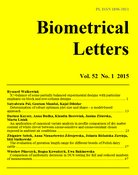
Biometrical Letters Vol. 52(1), 2015, pp. 23-35


|
AN APPLICATION OF CANONICAL VARIATE ANALYSIS IN PROFILE COMPARISON OF DRY MATTER CONTENT OF WHITE CLOVER BETWEEN OZONE-SENSITIVE AND OZONE-RESISTANT CLONES EXPOSED IN AMBIENT AIR CONDITIONS Dariusz Kayzer1, Anna Budka1, Klaudia Borowiak2, Janina Zbierska2, Marta Lisiak2 1Department of Mathematical and Statistical Methods, Poznan University of Life Sciences, Wojska Polskiego 28, 60-637 Poznań, Poland‚ e-mail: dkayzer@up.poznan.pl; budka@up.poznan.pl 2Department of Ecology and Environmental Protection, Poznan University of Life Sciences, Piątkowska 94C, 60-649 Poznań, Poland, e-mail: klaudine@up.poznan.pl; jzbier@up.poznan.pl; lismar@up.poznan.pl |

Tropospheric ozone affects plant growth and the yield of main pasture species all around the world. Experiments are usually performed in fully controlled conditions; the number of investigations in ambient air conditions is still limited. Moreover, most investigations of the effect of ozone on white clover biomass production consider one series after the other, including a period without leaves. Hence, based on the recommendations, additional series are proposed and studied here. The responses of sensitive and resistant white clover clones are presented and compared using multivariate analysis of variance and profile analysis. The canonical variate analysis used here makes it possible to present the profile comparison of dry matter content of white clover graphically in Euclidean space. The investigations revealed a difference in response between clones and the necessity of using the additional series.

multivariate analysis of variance, profile analysis, canonical variate analysis, ozone, dry weight, white clover
